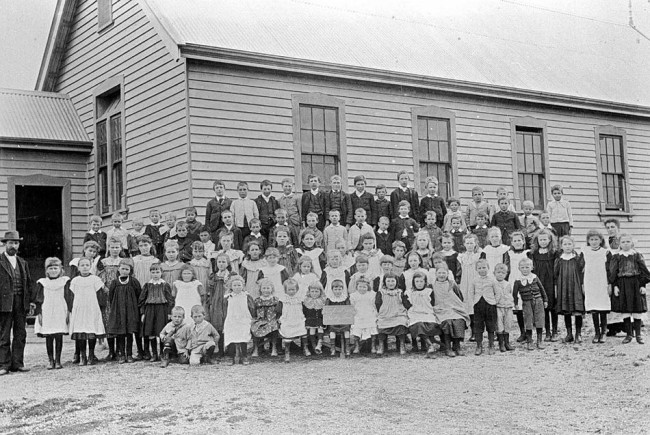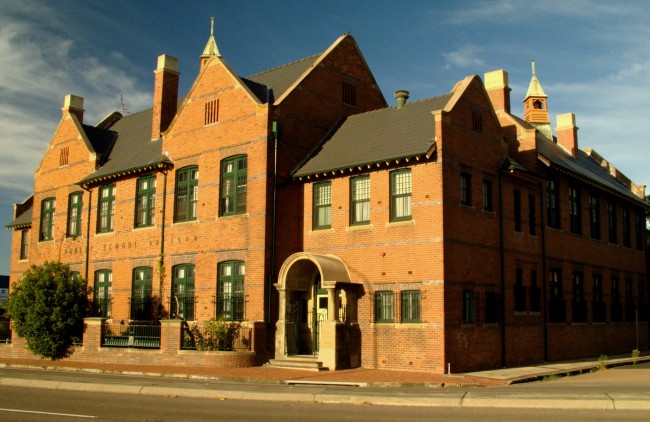Education in colonial Australia was far from the organized system in place today. In the late 1700’s and early 1800’s, children were lucky to have a one-room school house in the country or a private tutor in the city. These schools were founded by private individuals or churches, but were funded by the colonial governments or privately until the eventual emergence of state-run public schools in 1848.
Church-Run Schools
In the early days of settlement, there were no government standards in place for education. The wealthier classes could afford to pay the wife of a local doctor or lawyer to tutor their children, but in rural areas students would gather in bare-bones schoolhouses for instruction. These first schoolrooms were operated by the Church of England, and can be traced to Reverend Richard Johnson, who was the first Colonial Chaplain in Australia. In 1792, as he was establishing his colony, he wrote to the Society for the Propagation of the Gospel in Foreign Parts back in England about the need for education in Sydney. The first school was opened in Sydney’s Chapel Row in 1793 as a result. With an earthen floor and a roof thatched with cabbage palm leaves, the school provided rudimentary education for orphan girls. By 1797, six schools had opened in Australia, although these were not sufficient to cope with all of the children in need.
The education that was provided in these early church-sponsored schools doesn’t look remotely like the education that Australian children receive today. Johnson was more concerned about how to tame and civilize the children of convicts to create a more stable society. There’s no doubt that many students came from troubled backgrounds and needed the structure of education. Yet rather than the coping and communication methods you’d be taught in these counseling courses at NowLearning today, children were taught subjects such as the “Virtues of Chastity,” and “Dissuasion against Lying.”
The First Public Schools
Opponents of state-run schools felt that there was little need for education, arguing that it wasn’t necessary for the child of a farmer or blacksmith to learn how to read or write. The movement to teach all children these skills picked up steam by the 1830’s, however. Yet as with the first church-run schools, the main drive was to create a more moral society through education, preventing ignorance and crime as a result. The first public schools were launched in 1848, in Dunmore, Port Macquarie, Kempsey, Botany, and Hinton. These were able to take on 120 students between them, yet the system expanded rapidly and the first high schools were introduced in 1883.
The government created a strict curriculum and clear guidelines outlining acceptable student and teacher behavior. Boys and girls received the same instruction in basic subjects such as reading, writing, and arithmetic. Girls were also trained in sewing and knitting, while boys learned additional geography and arithmetic training. Thirty minutes of the day were allotted to singing, and all students had to be inspected to ensure that they had freshly washed faces, combed hair, and neat clothing. Students were taught the advantages of being polite, clean, and punctual to instil a sense of moral and civic duty. This dual system of church-run and state-run schools persisted until the 1870’s, when the two merged to create a more unified school system.
Australian students today have well-organized primary and secondary schools, as well as a vast network of higher education to choose from. All of this started with the seeds that were planted back in 1793 by Reverend Johnson.
Photo Credits
Students Outside Rocky Lead State School – Museum Victoria
Pupils & Teacher in Front of Clear Lake State School – Museum Victoria
Wickham Public School – Wikipedia Creative Commons
Guest Author Bio
Rachel MacDonald Rachel MacDonald is an Edinburgh-based freelance writer who has worked as a copywriter for businesses from Lima to San Francisco. She specializes in travel, design, and the arts.
Rachel MacDonald is an Edinburgh-based freelance writer who has worked as a copywriter for businesses from Lima to San Francisco. She specializes in travel, design, and the arts.
Recent Guest Author Articles:
- How Does Ultrasound Therapy Enhance Skin Firmness Without Surgery?
- From License to Lifestyle - How State Choice Impacts Nursing Journeys
- Your Online Reputation Is Everything (Here's How to Build It Fast)
- 5 Spiritual Resources to Help Humanity in Times of Crisis
- Between Judgment and Hope: Navigating the Gray Areas of the Justice System





Please Share Your Thoughts - Leave A Comment!